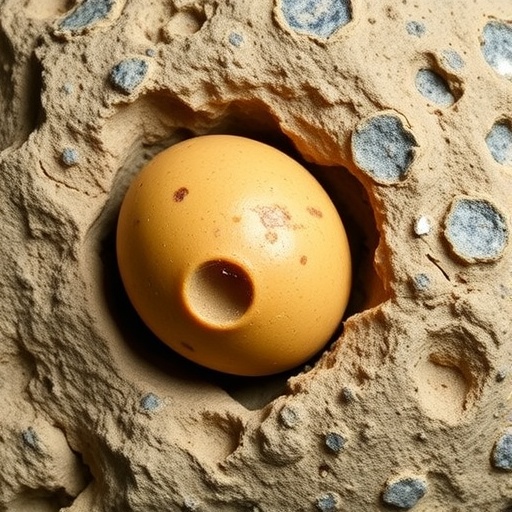In the vast chronicles of Earth’s history, the Late Cretaceous period marks a pivotal chapter where not only massive volcanic upheavals reshaped the planet, but also where global environmental transformations dictated the fate of innumerable species. Amidst these turbulent times, a remarkable scientific breakthrough has emerged from the Yunyang Basin in central China, shedding unprecedented light on the exact age of dinosaur eggs fossilized for millions of years. This groundbreaking research, led by Dr. Bi Zhao of the Hubei Institute of Geosciences, harnesses cutting-edge uranium-lead (U-Pb) carbonate dating to precisely determine the temporal context of dinosaur eggs from the Qinglongshan site. The findings offer a vivid glimpse into not just the timeline of these ancient eggs but also hint at evolutionary and climatic patterns that shaped dinosaur survival.
Qinglongshan, recognized as China’s premier national dinosaur egg fossil reserve, houses an extraordinary repository of over three thousand fossilized eggs distributed across several distinct excavation points. These fossils, largely embedded in a heterogeneous matrix of breccia and siltstone, reveal minimal deformation, suggesting a remarkable degree of preservation. Among these specimens, the majority are attributed to the species Placoolithus tumiaolingensis, classified within the family Dendroolithidae, known for their uniquely porous eggshell structure. The research team focused on a particular cluster of 28 eggs, notably embedded within breccia-bearing siltstone, to execute their precise radiometric dating.
Traditional dating methods in paleontology often rely indirectly on volcanic ash layers or sedimentary context, which may not always coincide accurately with the fossilized eggs’ deposition. However, Dr. Zhao’s approach revolutionizes this paradigm by directly dating the carbonate minerals cemented within the eggshells themselves. Employing in-situ carbonate U-Pb dating, the method utilizes a focused micro-laser to vaporize minute quantities of carbonate, producing aerosol samples. These aerosols undergo mass spectrometry to precisely quantify uranium and lead isotopes. Given uranium’s predictable radioactive decay into lead, measuring the isotopic ratios effectively sets an atomic clock, pinpointing the fossil’s formation with remarkable accuracy.
The results of this sophisticated dating technique reveal that the dinosaur eggs from the Qinglongshan site were laid approximately 85 million years ago, within the Late Cretaceous epoch. This temporal placement is crucial as it narrows the uncertainty window to roughly 1.7 million years before or after, providing the most robust chronological constraint for these specimens to date. This is a monumental step forward, as previous attempts to date these eggs were impeded by geological complexities and relied heavily on indirect stratigraphic correlations.
Beyond dating, these insights open a new frontier to understand the interplay between dinosaur reproduction and the Earth’s changing climate. The Late Cretaceous was characterized by a notable global cooling trend that began several million years earlier, during the Turonian epoch. Temperatures had declined substantially by the time these eggs were laid. This gradual cooling likely exerted evolutionary pressure on dinosaur populations, influencing species diversity and reproductive strategies at Qinglongshan and beyond.
One particularly intriguing hypothesis arising from this study relates to the distinctive pore structures observed in Dendroolithidae eggs. These specialized microscopic channels may have been an adaptive response to shifting environmental conditions, especially fluctuations in humidity and temperature associated with the cooling climate. The researchers suggest that these adaptations allowed for optimized gas exchange necessary for embryo development. Yet, by examining Placoolithus tumiaolingensis, it appears this lineage might have encountered an evolutionary dead end, potentially due to an inability to sufficiently adapt to the sustained climatic decline.
While the study’s paleontological sampling was limited, analyses across multiple eggshell fragments consistently corroborated the 85-million-year dating estimate. The consistency also aligns with the surrounding sedimentary rock ages, thereby cross-validating the findings. This integrated approach of isotope geochemistry and sedimentology paves the way for broader investigations into other fossil deposits, promising to refine regional geological timelines and enhance our understanding of dinosaur migration and evolution across ancient ecosystems.
Further ambitions of the research team include expanding sample collection to encompass eggs found within varied stratigraphic horizons. Such comprehensive data will enable the construction of detailed chronologies, improving temporal resolution for fossil assemblages across different geologic formations. Moreover, investigating Dendroolithid eggs from adjacent basins could illuminate potential migratory patterns, shedding light on habitat shifts and survival strategies employed by dinosaurs in response to climate fluctuations.
On a larger scale, these findings carry profound implications for the study of extinction mechanisms and environmental dynamics during the Late Cretaceous. By transforming dinosaur eggs into precise chronological markers, scientists can better contextualize paleoclimatic data, fossil distribution, and evolutionary turnover. Dr. Zhao emphasizes that such refined chronological frameworks are critical to narrating Earth’s deep history, linking fossil evidence to broader geological and ecological transformations.
Notably, this research contributes significantly to geochronology methods within paleontology, showcasing the analytical power of direct in-situ dating on carbonate materials. The approach circumvents limitations of conventional dating reliant on the geological context, offering a direct window into the biological materials themselves. This innovation holds promise for redefining timelines across diverse fossil assemblages, fostering more intricate reconstructions of past life.
In conclusion, the study by Dr. Zhao and colleagues marks an extraordinary advance in our ability to date and interpret fossilized dinosaur eggs precisely. The amalgamation of geological, chemical, and biological expertise reveals a vivid portrait of ancient ecosystems navigating climatic shifts. As this line of inquiry progresses, it will undoubtedly enrich our understanding of prehistoric life, climate-driven evolution, and the complex factors influencing species success and extinction during one of Earth’s most dynamic epochs.
Subject of Research: Not applicable
Article Title: Geological Age of the Yunyang Dinosaur Eggs Revealed by in-situ Carbonate U-Pb Dating and Its Scientific Implications
News Publication Date: 11-Sep-2025
Web References: http://dx.doi.org/10.3389/feart.2025.1638838
Image Credits: Dr. Bi Zhao
Keywords: Late Cretaceous, dinosaur eggs, uranium-lead dating, carbonate U-Pb, Qinglongshan fossil site, Placoolithus tumiaolingensis, Dendroolithidae, paleoclimate, fossil geochronology, mass spectrometry, evolutionary adaptation, global cooling




